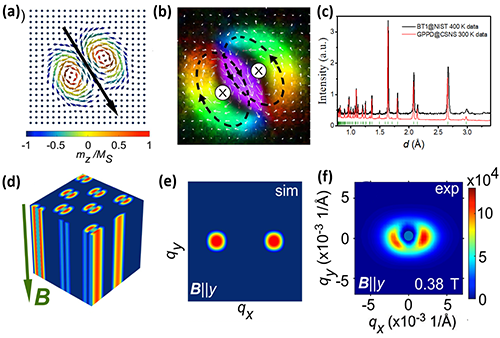Oriented 3D Magnetic Biskyrmions studied in MnNiGa Bulk Crystals
Date:08-04-2019 Print
In recent years, the studying of quantum materials has become a focus in the research field of condensed matter physics. Quantum materials often have non-trivial topological properties. The magnetic skyrmion material is a kind of quantum material with a nanoscale topological spin vortex structure. They have attracted considerable attention, not only from the perspective of fundamental theory but also for their potential technological applications. The existence of biskyrmions which consist of two bound, topologically stable skyrmion spin textures, has been confirmed by real-space imaging with Lorentz transmission electron microscopy in quasi-two-dimensional thin plate samples, especially Prof. WANG Wenhong and Prof. ZHANG Ying from Institute of Physics, Chinese Academy of Sciences (IOP, CAS) did a lot of works. However, to the best of our knowledge, our paper first reported a small angle neutron scattering (SANS) studying results which revealed the bulk nature of biskyrmions in MnNiGa.
Prof. WANG Fangwei and Mr. LI Xiyang from IOP, CAS collaborated with Prof. WANG Wenhong from IOP, CAS, and Prof. HESJEDAL Thorsten and Dr. ZHANG Shilei from the University of Oxford performed SANS and numerical simulation on MnNiGa. We find that biskyrmions stack into 3D, probably tube-like structures along the magnetic field direction, similar to skyrmion tube structures in chiral magnets (Figure 1). Further, biskyrmions do not assemble into a long-range-ordered lattice in bulk crystals, and they are in-plane rotationally ordered, with the rotation being locked to certain crystallographic directions, governed by the magnetocrystalline anisotropy (Figure 2). Such anisotropic nature, representing an extra degree of freedom for this type of skyrmions, may be exploited as information carrier. We believe that our discovery will have a profound impact in the skyrmion science, highlighting the fascinating properties of higher order skyrmions.
This study entitled “Oriented 3D Magnetic Biskyrmions in MnNiGa Bulk Crystals” was published on Advanced Materials.
The study was supported by the National Natural Science Foundation of China (No. 11675255), the National Key R&D Program by MOST of China (No. 2016YFA0401503 and No. 2017YFA0303202), EPSRC (EP/N032128/1), the Key Research Program of the Chinese Academy of Sciences (KJZD-SW-M01), the Swiss National Science Foundation (SNSF) via the Sinergia network “NanoSkyrmionics” (Grant No. CRSII5-171003) and the Newton-China fund (RB1620128).
 |
| Figure 1: a) TwoDnskyrmions are brought together in a ferromagnetic background forming aC2vbiskyrmion. The principle symmetry axis is labeled by the black arrow, which gives also the direction of the biskyrmion. b) An in-plane magnetization of the biskyrmion configuration. c) The neutron diffraction data measured at T above and below Tc. d) Illustration of the 3D magnetization distribution of the disordered biskyrmion phase in an applied out-of-plane field of 0.38 T. e,f) Simulated and experimental SANS pattern for the (d) corresponding state. (Reproduced fromX. Li et al.,Adv. Mater. 1900264 (2019)) |
 |
| Figure 2: Experimental SANS pattern in theki||Bconfiguration for applied fields of 0.4 T in MnNiGa single crystal sample (left panel) and the corresponding simulated SANS pattern (right panel). (Reproduced fromX. Li et al.,Adv. Mater.1900264 (2019)) |
Contact:
Institute of Physics
WANG Fangwei
Email:fwwang@iphy.ac.cn
Key word:
biskyrmions, disorder, MnNiGa, small-angle neutron scattering
Abstract:
A biskyrmion consists of two bound, topologically stable, skyrmion spin textures. These coffee‐bean‐shaped objects are observed in real space in thin plates using Lorentz transmission electron microscopy (LTEM). From LTEM imaging alone, it is not clear whether biskyrmions are surface‐confined objects, or, analogous to skyrmions in noncentrosymmetric helimagnets, 3D tube‐like structures in a bulk sample. Here, the biskyrmion form factor is investigated in single‐ and polycrystalline‐MnNiGa samples using small angle neutron scattering. It is found that biskyrmions are not long‐range ordered, not even in single crystals. Surprisingly all of the disordered biskyrmions have their in‐plane symmetry axis aligned along certain directions, governed by the magnetocrystalline anisotropy. This anisotropic nature of biskyrmions may be further exploited to encode information.


